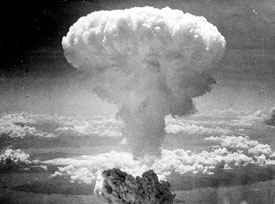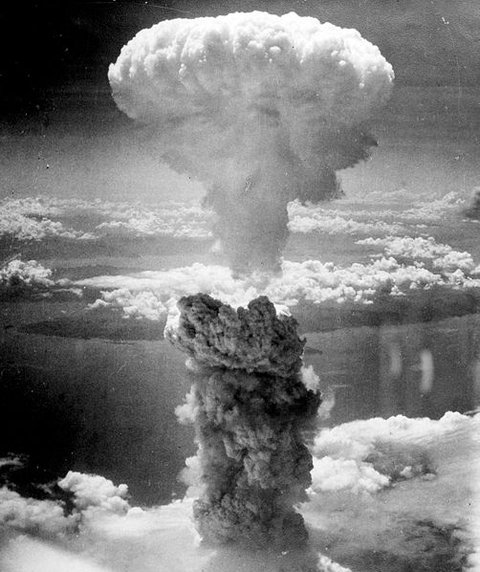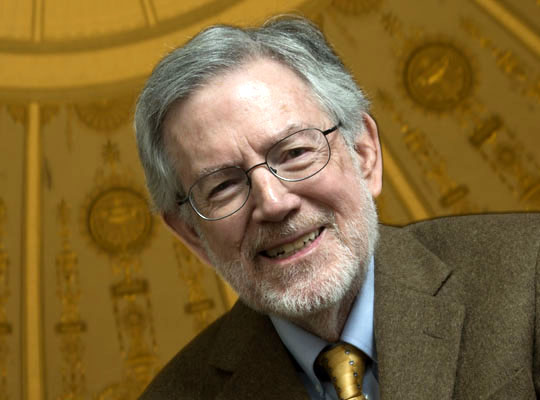“My father was 26 when he helped drop the bomb”
SMU Prof. Emeritus Jim Hopkins reflects on his father’s role in the atomic bombing of Nagasaki 70 years ago.

 A photograph of the atomic bombing of Nagasaki on August 9, 1945, taken from one of the B-29 Superfortresses used in the attack. Although it is not known exactly how many were killed, estimates place the number at roughly 39,000–80,000. (Photo courtesy of the National Archives.) |
DALLAS (SMU) — Come Sunday, it will have been 70 years since the United States dropped the second of two atomic bombs on Japan, targeting the major port city of Nagasaki in a bid to end World War Two.
In the seven decades since, no nation has dared drop another.
While many mark this anniversary as a somber day, for SMU History Professor Emeritus Jim Hopkins, it’s a bit more personal.
His father was Major James I. Hopkins, a Texas A&M alum and native of Palestine, Texas, and Group Operations Officer of the elite unit that dropped the bombs and piloted one of the three planes that flew the mission on Nagasaki on August 9, 1945.
“As a historian, it’s very easy to look retrospectively at the bombings and raise serious questions about whether they were necessary to end the war,” Hopkins says.
“(But) to understand our decision, it is also necessary to empathize with the political, military and moral culture of the time,” Hopkins adds. “As a citizen or a soldier whose views, particularly of the Japanese, had been shaped by events such as the attack on Pearl Harbor, the Bataan death march and such bitter island campaigns as Iwo Jim, Saipan and, particularly, Okinawa, this seemed, at last, as a way to end the terrible war.”
Two weeks after the bombs were dropped, a gallop poll revealed 85 percent of Americans approved the act.
Today, with more known about alternatives to the mission and its opposition from many of the scientists who built the bomb, as well as leading military figures such as General Eisenhower, support is far more divided.
That difference between that 1940s view of the destruction of Hiroshima and Nagasaki by atomic bombs and the historic perspective holds an important lesson for citizens of today, Hopkins says: There has to be a better citizen understanding of science.
“Look at the Iran nuclear deal,” Hopkins says. “That’s a 159-page document that’s complicated, but if we leave the debate over whether it is, on balance, good or bad to those who don’t take the time to understand the issues, but simply shout and compete for sound bites and TV time, we’re in dangerous waters.”
 Prof. Emeritus Jim Hopkins |
“In a democratic society, we must embrace the responsibility to make our informed views felt on issues such as climate change and nuclear proliferation,” Hopkins adds.
Hopkins doesn’t think he and his dad, who died in 1951 when Hopkins was nine, would be in perfect agreement on the dropping of the bomb if they could talk today, but he understands why his dad, and the overwhelming majority of Americans, felt it had to be done: The world’s well-being was at stake.
The important thing, says Hopkins, is to draw the right lessons from the past as we march toward the future.
“It was a great opportunity for rethinking the role of science in society,” Hopkins says. “People in a democratic society can’t close their ears and eyes to the role science plays and allow debate and decisions affecting not only our own country, but the planet on which we live, to be dominated by the loudest voices.”
Professor Hopkins developed an SMU course on the Manhattan Project. He will be speaking on the atomic bomb in a program at the Frontiers of Flight Museum Spirit of 45 at 2 p.m. August 15.
###
SMU is a nationally ranked private university in Dallas founded 100 years ago. Today, SMU enrolls approximately 11,000 students who benefit from the academic opportunities and international reach of seven degree-granting schools.
21298-nr-8/7/15-kr